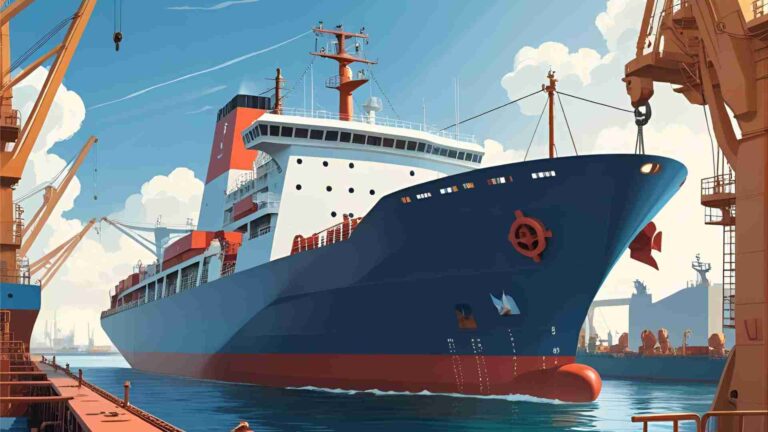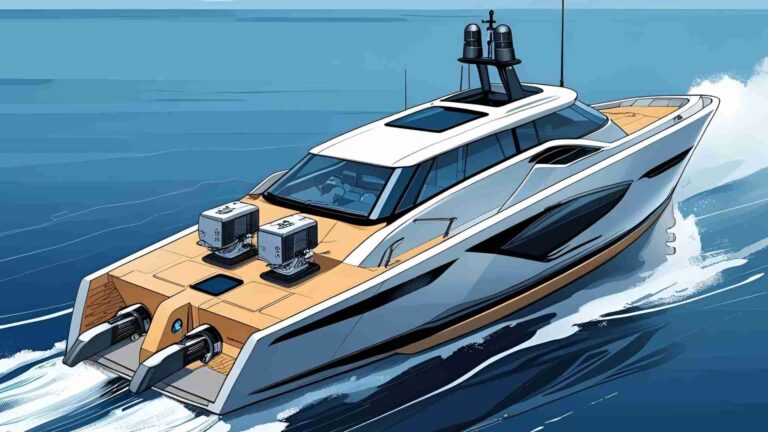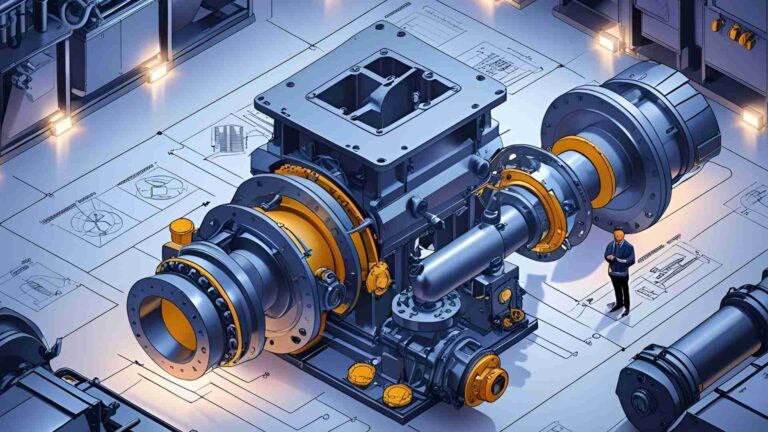An Introduction to Ship Automation and Control Systems
Explore ship automation and control systems: key components, functions, and benefits for efficient, safe maritime operations.
The maritime industry has undergone a significant transformation with the integration of automation and control systems, which have become the backbone of modern ship operations. These systems enhance safety, optimize efficiency, and ensure compliance with stringent environmental regulations. By automating critical processes, they reduce human error, lower operational costs, and improve the reliability of complex maritime systems. This article provides an in-depth exploration of ship automation and control systems, their key components, applications, benefits, and the challenges faced by ship engineers in managing these technologies.
The Role of Automation in Modern Maritime Operations
Ship automation and control systems are engineered to manage a vessel’s critical operations, from propulsion and power generation to environmental monitoring and safety protocols. These systems integrate advanced technologies such as sensors, programmable logic controllers (PLCs), and centralized control interfaces to streamline operations, reduce crew workload, and enhance decision-making. The adoption of automation is driven by the need to address rising energy costs, comply with environmental regulations like the International Maritime Organization’s (IMO) greenhouse gas (GHG) emissions targets, and meet the growing demand for larger, more efficient vessels.
Automation systems allow ships to operate with greater precision, enabling real-time monitoring and control of machinery, navigation, and cargo operations. They also support predictive maintenance, helping engineers address potential issues before they escalate. For shipbuilders and operators, these systems translate into reduced operational expenditures (OpEx), extended equipment lifespans, and improved safety for crew and cargo.
Key Components of Ship Automation Systems
Ship automation systems consist of several critical components that work together to ensure seamless vessel operation. Below is an overview of the primary elements and their functions:
1. Control Panels
Control panels serve as centralized hubs where ship engineers monitor and manage all vessel operations. Equipped with intuitive interfaces, these panels display real-time data from various systems, including engine performance, power distribution, and environmental conditions. Modern control panels often feature touchscreens and integrated software for enhanced usability.
2. Sensors
Sensors are the eyes and ears of automation systems, collecting data on parameters such as temperature, pressure, vibration, and fluid levels. This data feeds into decision-support systems, enabling automated adjustments to machinery or triggering alarms when anomalies are detected. For example, temperature sensors in the engine room can detect overheating, prompting automatic cooling adjustments.
3. Alarm Systems
Alarm systems are designed to alert crew members to abnormal conditions, such as low oil pressure or fire detection. These systems are categorized by severity:
- Warning Alarms: Indicate minor deviations that require monitoring.
- Critical Alarms: Signal urgent issues, such as engine malfunctions, necessitating immediate action.
Alarms are displayed on control panels and often accompanied by audible alerts to ensure timely responses.
4. Engine and Machinery Control
Automated systems manage critical engine functions, including fuel injection, cooling, and lubrication. For instance, fuel management systems optimize injection timing to reduce emissions and improve efficiency. Similarly, automated cooling systems adjust water pump speeds to maintain optimal temperatures, reducing wear on machinery.
5. Safety Systems
Safety systems monitor fire detection, intrusion, and emergency response protocols. These systems can automatically shut down equipment or activate fire suppression systems in critical situations, minimizing risks to the crew and vessel.
6. Communication and Data Management
Effective communication between ship and shore is vital for operational coordination. Automation systems facilitate data exchange, enabling remote diagnostics, voyage planning, and compliance reporting. These systems ensure seamless integration with shore-based control centers.
7. Maintenance and Diagnostics
Predictive maintenance systems analyze data from sensors to predict equipment failures before they occur. By identifying trends, such as increasing vibration levels, these systems allow engineers to schedule maintenance proactively, reducing downtime and repair costs.
8. Environmental Monitoring
Environmental monitoring systems ensure compliance with regulations, such as IMO’s GHG emissions targets. These systems track emissions, ballast water treatment, and waste management, helping vessels meet stringent environmental standards.
Specific Automation Systems and Their Applications
Several specialized automation systems are deployed on modern ships to manage specific functions. Below are some key systems and their applications:
| System | Description | Applications |
|---|---|---|
| Integrated Automation System (IAS) | A comprehensive platform for controlling multiple ship systems, including propulsion, power, and auxiliary machinery. | Engine monitoring, cargo control, safety management. |
| K-Chief Marine Control System | A robust system for vessel management, offering alarm monitoring, safety, and cargo control. | Alarm handling, cargo operations, system integration. |
| mtu NautIQ Master | An Integrated Platform Management System (IPMS) that unifies subsystems for seamless operation. | Propulsion, power distribution, system diagnostics. |
| Propulsion Optimization System (POS) | Optimizes propulsion efficiency by adjusting engine parameters based on environmental conditions. | Fuel efficiency, emission reduction. |
| Remote Control Systems | Enables remote operation of systems like controllable pitch propellers and electric propulsion. | Remote diagnostics, propulsion control. |
| Navigation and Voyage Systems | Optimizes sailing routes based on weather, currents, and fuel efficiency. | Route planning, fuel optimization. |
| Cargo Monitoring Systems (CMS) | Monitors cargo conditions, such as temperature and pressure, in real-time. | Cargo safety, regulatory compliance. |
Example: K-Chief Marine Control System
The K-Chief system, developed by Kongsberg Maritime, is widely used in the maritime industry for its versatility. It integrates alarm monitoring, safety management, and cargo control into a single platform. The system’s modular design allows customization based on vessel type, making it suitable for tankers, container ships, and offshore vessels. Pricing for K-Chief systems varies depending on configuration but typically ranges from $100,000 to $500,000 for large vessels, excluding installation and maintenance costs.
Example: mtu NautIQ Master
The mtu NautIQ Master, developed by Rolls-Royce, is an IPMS that integrates propulsion, power, and auxiliary systems. It provides a unified interface for monitoring and control, reducing the complexity of managing multiple subsystems. The system’s advanced diagnostics capabilities help predict maintenance needs, extending equipment life. Costs for mtu NautIQ Master systems start at approximately $200,000 for mid-sized vessels, with higher-end configurations exceeding $1 million.
Engine Room Automation: A Closer Look
The engine room is the heart of a ship, and automation plays a pivotal role in ensuring its reliable operation. Engine room automation systems use sensors, controllers, and actuators to manage engines, generators, and auxiliary machinery. These systems reduce the need for constant manual oversight, allowing engineers to focus on troubleshooting and optimization.
Centralized Control Rooms
Modern ships feature centralized control rooms equipped with computer systems that integrate data from engine performance, alarms, and automation controls. These rooms provide a single point of access for monitoring and adjusting machinery settings, improving response times to issues. For example, a centralized control room can display real-time data on fuel consumption, enabling engineers to optimize engine performance during long voyages.
Automation of Key Processes
Engine room automation manages critical processes such as:
- Fuel Injection: Adjusts timing and volume to optimize combustion and reduce emissions.
- Cooling Systems: Regulates water pump speeds to maintain safe operating temperatures.
- Lubrication: Ensures consistent oil flow to reduce friction and wear.
- Power Generation: Balances load across generators to optimize fuel efficiency.
By automating these processes, ships achieve greater fuel efficiency, reduced emissions, and lower maintenance costs. For instance, automated fuel management can reduce fuel consumption by up to 10%, depending on vessel type and operating conditions.
Safety and Emergency Systems
Engine room automation enhances safety by continuously monitoring parameters like temperature, pressure, and vibration. If a parameter exceeds safe limits, the system can trigger alarms or initiate automatic shutdowns to prevent damage. For example, if oil pressure drops below a critical threshold, the system may shut down the engine to avoid catastrophic failure.
Programmable Logic Controllers (PLCs) in Ship Automation
PLCs are digital computers designed to control mechanical processes in harsh environments. In ship automation, PLCs manage systems like fuel pumps, ballast water treatment, and ventilation.
Role of PLCs
PLCs receive input from sensors and execute programmed logic to control machinery. For example, a PLC controlling a ballast pump adjusts flow rates based on water level and pressure data, ensuring precise control over ship stability. PLCs are integral to systems like the IAS and K-Chief, providing reliable automation across multiple subsystems.
Advantages of PLCs
- Reliability: Designed to withstand vibration, humidity, and extreme temperatures.
- Flexibility: Easily reprogrammable to accommodate changes in machinery or operational needs.
- Scalability: Suitable for both small and large vessels, from ferries to supertankers.
Maintenance and Troubleshooting
Ship engineers must be proficient in PLC maintenance, including diagnosing hardware issues (e.g., faulty input/output modules) and reprogramming logic. Regular inspections ensure PLCs operate reliably, while training in PLC programming is essential for effective troubleshooting.
Diagram: PLC Workflow in Ship Automation

This diagram illustrates how PLCs process sensor data, execute control logic, and adjust machinery operations, with feedback loops ensuring continuous monitoring.
Alarm and Monitoring Systems
Alarm and monitoring systems are critical for identifying and addressing issues before they escalate. These systems collect real-time data from sensors and display it on control panels, enabling engineers to track machinery performance.
Types of Alarms
- Warning Alarms: Indicate minor issues, such as a slight increase in engine temperature.
- Critical Alarms: Signal severe malfunctions, such as low oil pressure, requiring immediate action.
Monitoring and Data Logging
Monitoring systems track parameters like fuel consumption, vibration, and emissions. Data logging capabilities store historical data, allowing engineers to analyze trends and plan maintenance. For example, a gradual increase in vibration may indicate bearing wear, prompting preemptive repairs.
Automation of Auxiliary Machinery
Auxiliary machinery, such as power generators, pumps, and ventilation systems, is critical for daily operations. Automation ensures these systems operate efficiently with minimal manual intervention.
Power Generation
Automated power management systems balance load across generators, optimizing fuel consumption and reducing wear. For instance, during low-demand periods, the system may shut down excess generators to save fuel.
Pump Automation
Automated pumps regulate flow rates for systems like bilge management and ballast handling. These systems maintain ship stability and comply with environmental regulations, such as ballast water treatment standards.
Air Conditioning and Ventilation
Automation maintains optimal conditions in crew quarters, engine rooms, and cargo holds. Sensors adjust airflow and temperature to prevent overheating or excessive humidity, ensuring crew comfort and equipment reliability.
Integrated Ship Systems
Integrated ship systems combine multiple automation processes into a single interface, providing a comprehensive view of vessel operations. Systems like the IAS and mtu NautIQ Master enable engineers to monitor propulsion, power, and auxiliary systems from one console.
Benefits of Integration
- Efficiency: Simplifies management of complex systems.
- Safety: Reduces the risk of conflicting operations.
- Decision-Making: Provides real-time data for faster responses.
Challenges
Integrated systems are complex and require extensive training. Engineers must be prepared to troubleshoot system failures and revert to manual controls if necessary.
The Connected Vessel Vision
The concept of a “connected vessel” integrates automation with digital technologies to optimize operations across the vessel lifecycle. By connecting onboard systems with shore-based control centers, operators can achieve:
- Real-Time Diagnostics: Remote monitoring of equipment health.
- Sustainability: Compliance with environmental regulations through optimized systems.
- Cost Savings: Reduced OpEx through predictive maintenance and efficient operations.
For example, Floating Production Storage and Offloading (FPSO) vessels use connected systems to streamline production, reduce downtime, and meet ESG (Environmental, Social, and Governance) goals.
Challenges in Ship Automation
While automation offers significant benefits, it also presents challenges:
- Complexity: Integrated systems require advanced training and expertise.
- Cybersecurity: Connected vessels are vulnerable to cyber threats, necessitating robust security measures.
- Cost: High initial investment for systems like IAS or mtu NautIQ Master.
- Reliability: Dependence on automation requires backup systems to ensure redundancy.
Specifications and Pricing
| System | Key Features | Estimated Cost |
|---|---|---|
| K-Chief Marine Control System | Alarm monitoring, cargo control, safety management. | $100,000–$500,000 |
| mtu NautIQ Master | Integrated platform for propulsion and power management. | $200,000–$1,000,000+ |
| Propulsion Optimization System | Fuel efficiency, emission reduction. | $50,000–$200,000 |
| Cargo Monitoring System | Real-time cargo condition monitoring. | $30,000–$150,000 |
Note: Prices vary based on vessel size, configuration, and installation requirements. For detailed pricing, contact suppliers like Kongsberg Maritime or Rolls-Royce.
The Role of Automation in Meeting Industry Challenges
The maritime industry faces challenges like rising fuel costs, labor shortages, and stringent environmental regulations. Automation addresses these by:
- Reducing Fuel Consumption: Systems like POS optimize propulsion, cutting fuel use by up to 10%.
- Lowering Crew Requirements: Automation reduces onboard headcount, addressing labor shortages.
- Ensuring Compliance: Environmental monitoring systems help meet IMO GHG targets.
Future Trends in Ship Automation
The future of ship automation lies in advancements like artificial intelligence (AI) and machine learning. These technologies will enhance predictive maintenance, optimize voyage planning, and improve cybersecurity. Autonomous vessels, which rely entirely on automation, are also on the horizon, promising further reductions in operational costs and human error.
Conclusion
Ship automation and control systems are transforming the maritime industry by enhancing efficiency, safety, and sustainability. From engine room automation to integrated systems like the K-Chief and mtu NautIQ Master, these technologies enable precise control over complex operations. By mastering these systems, ship engineers can optimize performance, reduce costs, and ensure compliance with environmental regulations. As the industry evolves, automation will continue to play a pivotal role in shaping the future of maritime operations, driving innovation and operational excellence.
Happy Boating!
Share An Introduction to Ship Automation and Control Systems with your friends and leave a comment below with your thoughts.
Read The International Safety Management (ISM) Code until we meet in the next article.






